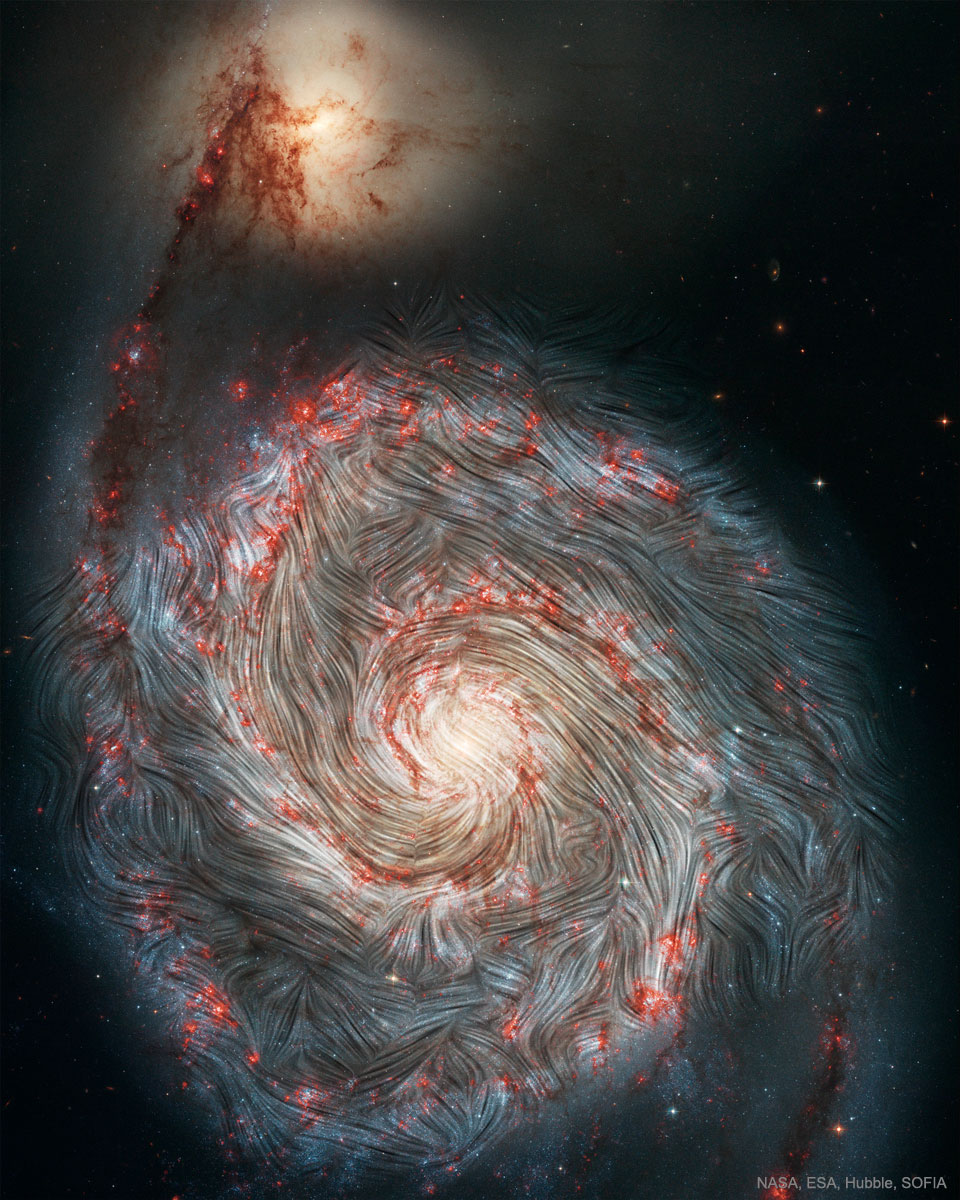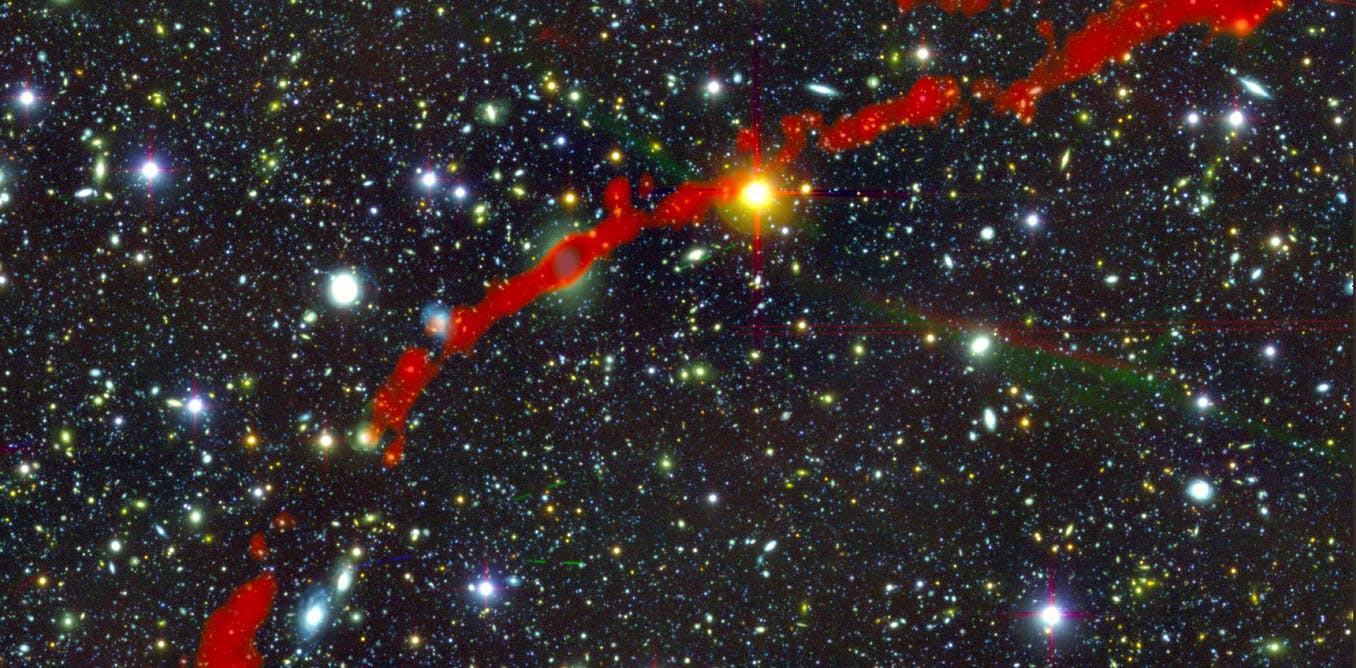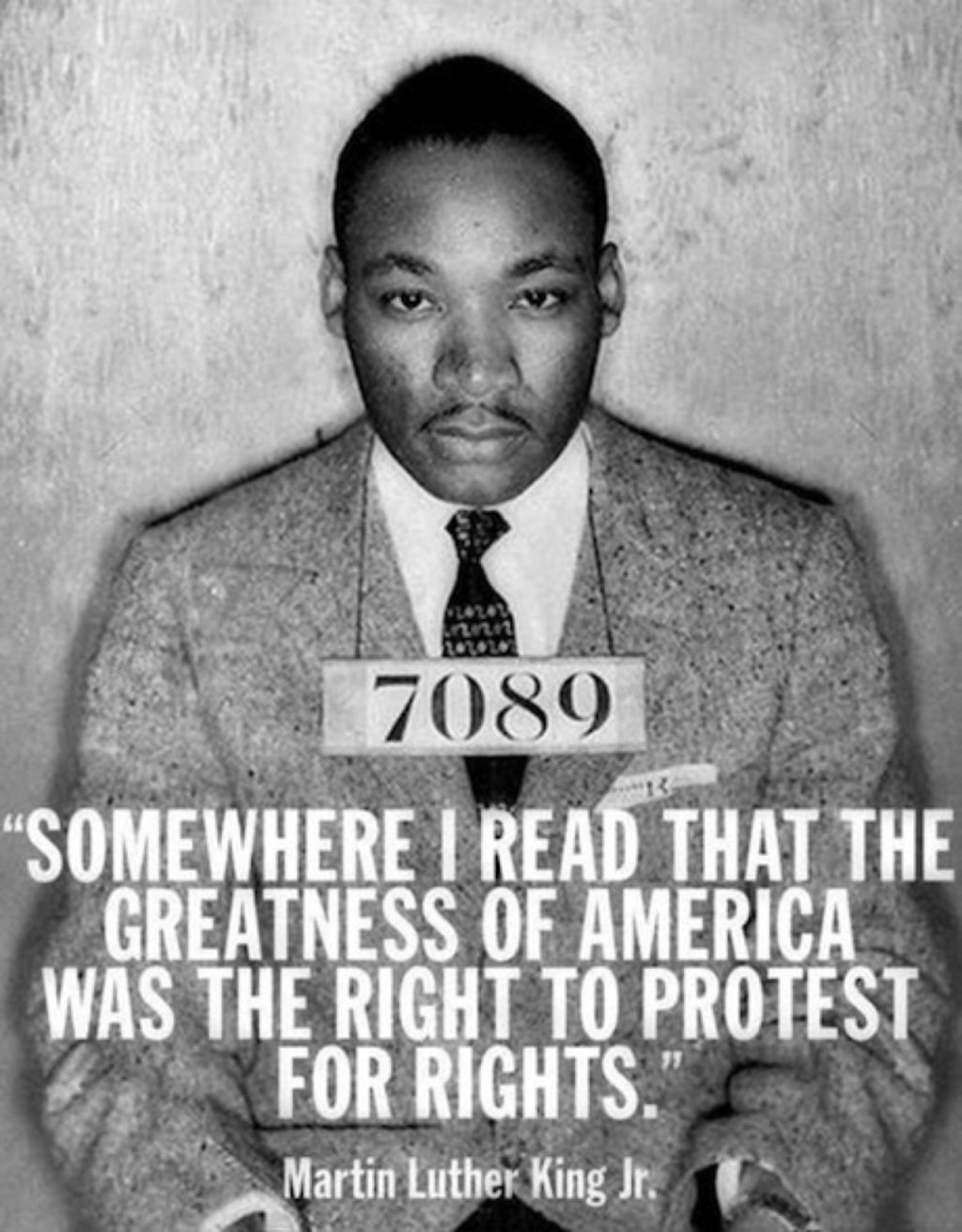Blog
Our face-on view of the Whirlpool Galaxy (M51) allows a spectacularly clear view of the spiral wave pattern in a disk-shaped galaxy. When observed with a radio telescope, the magnetic field appears to trace the arms’ curvature. However, with NASA’s flying Stratospheric Observatory for Infrared Astronomy (SOFIA) observatory, the magnetic field at the outer edge of M51’s disk appears to weave across the arms instead. Magnetic fields are inferred by grains of dust aligning in one direction and acting like polaroid glasses on infrared light. In the featured image, the field orientations determined from this polarized light are algorithmically connected, creating streamlines. Possibly the gravitational tug of the companion galaxy, at the top of the frame, on the dusty gas of the reddish star-forming regions, visible in the Hubble Space Telescope image, enhances turbulence — stirring the dust and lines to produce the unexpected field pattern of the outer arms.

January 20th 1960.
Jeff “Tain” Watts is one of the most in demand jazz drummers in the world today. Jeff Watts majored in classical percussion at Pittsburgh’s Duquesne University, where he was primarily a timpanist, followed by enrollment at the Berklee School of Music, where he pursued jazz studies alongside such talented players as Branford Marsalis, Kevin Eubanks, Greg Osby, Aimee Mann, Steve Vai and Marvin “Smitty” Smith.
Jeff joined the Wynton Marsalis Quartet in 1981 and proceeded to win three Grammy Awards with the ensemble. Watts left Wynton Marsalis in 1988. After working with George Benson, Harry Connick. Jr. and McCoy Tyner, he joined the Branford Marsalis Quartet in 1989.
Jeff has worked in the film and television industry as both a musician on the Tonight Show with Jay Leno and as an actor, Rhythm Jones in Spike Lee’s “Mo Better Blues”. Jeff joined Kenny Garrett’s band after returning to New York in 1995 after three years in LA on the Tonight Show. Watts also continued to record and tour with Branford Marsalis as well as Danilo Perez, Michael Brecker, Betty Carter, Kenny Kirkland, Courtney Pine, Geri Allen, Alice Coltrane, Greg Osby, Steve Coleman, Gonzalo Rubalcaba, and Ravi Coltrane.
https://www.youtube.com/watch?v=LkjXMYvYvZw
more...Wilbur James Cobb (January 20, 1929 – May 24, 2020) was an American jazz drummer. He was part of Miles Davis‘s First Great Sextet. At the time of his death, he had been the band’s last surviving member for nearly thirty years. He was awarded an NEA Jazz Masters Fellowship in 2009.
Cobb was born in Washington, D.C. on January 20, 1929. Before he began his music career, he listened to jazz albums and stayed awake into the late hours of the night in order to listen to Symphony Sid performing in New York City. Cobb started his touring career in 1950 with the saxophonist Earl Bostic. He subsequently performed with vocalist Dinah Washington, pianist Wynton Kelly, saxophonist Cannonball Adderley, bassist Keter Betts, Frank Wess, Leo Parker, and Charlie Rouse. His website also recounts his gigs with Billie Holiday, Pearl Bailey, and Dizzy Gillespie that took place before 1957.
more...Huddie William Ledbetter (/ˈhjuːdi/; January 23, 1888 – December 6, 1949), better known by the stage name Lead Belly, was an American folkand blues singer, musician and songwriter notable for his strong vocals, virtuosity on the twelve-string guitar, and the folk standards he introduced, including his renditions of “Goodnight, Irene“, “Midnight Special“, “Cotton Fields“, and “Boll Weevil“.
Lead Belly usually played a twelve-string guitar, but he also played the piano, mandolin, harmonica, violin, and windjammer. In some of his recordings, he sang while clapping his hands or stomping his foot.
Lead Belly’s songs covered a wide range of genres and topics including gospel music; blues about women, liquor, prison life, and racism; and folk songs about cowboys, prison, work, sailors, cattle herding, and dancing. He also wrote songs about people in the news, such as Franklin D. Roosevelt, Adolf Hitler, Jean Harlow, Jack Johnson, the Scottsboro Boys and Howard Hughes. Lead Belly was posthumously inducted into the Rock and Roll Hall of Fame in 1988 and the Louisiana Music Hall of Fame in 2008.
Though many releases credit him as “Leadbelly”, he himself wrote it as “Lead Belly”, which is also the spelling on his tombstone and the spelling used by the Lead Belly Foundation.
more...Name: MGTC J095959.63+024608.6
Distance: 2.08 billion light-years
Diameter: 2.42 Mpc (7.9 million light-years)

Robert Allen Palmer (19 January 1949 – 26 September 2003) was an English singer-songwriter, musician and record producer. He was known for his powerful, distinctive, gritty and soulful voice, sartorial elegance and for combining soul, jazz, rock, pop, reggae and blues.
Palmer’s involvement in the music industry began in the 1960s, covered four decades and included a spell with the band Vinegar Joe. He found success both in his solo career and with the Power Station, and had Top 10 songs in both the United Kingdom and the United States in the 1980s. Three of his hit singles, “I Didn’t Mean to Turn You On“, “Addicted to Love” and “Simply Irresistible“, were accompanied with stylish music videos directed by British fashion photographer Terence Donovan.
Palmer received a number of awards throughout his career, including two Grammy Awards for Best Male Rock Vocal Performance, an MTV Video Music Award and two Brit Award nominations for Best British Male Solo Artist. He died aged 54, following a heart attack on 26 September 2003.
more...Janis Lyn Joplin (January 19, 1943 – October 4, 1970 {Port Authur, TX) was an American singer-songwriter who sang rock, soul and blues music. One of the most successful and widely known rock stars of her era, she was noted for her powerful mezzo-soprano vocals and “electric” stage presence. In 1967, Joplin rose to fame following an appearance at Monterey Pop Festival, where she was the lead singer of the then little-known San Francisco psychedelic rock band Big Brother and the Holding Company. After releasing two albums with the band, she left Big Brother to continue as a solo artist with her own backing groups, first the Kozmic Blues Band and then the Full Tilt Boogie Band. She appeared at the Woodstock festival and the Festival Express train tour. Five singles by Joplin reached the Billboard Hot 100, including a cover of the Kris Kristofferson song “Me and Bobby McGee“, which reached number one in March 1971. Her most popular songs include her cover versions of “Piece of My Heart“, “Cry Baby“, “Down on Me“, “Ball and Chain“, and “Summertime“; and her original song “Mercedes Benz“, her final recording. Joplin died of an accidental heroin overdose in 1970 aged 27, after releasing three albums. A fourth album, Pearl, was released in January 1971, just over three months after her death. It reached number one on the Billboard charts. She was posthumously inducted into the Rock and Roll Hall of Fame in 1995. Rolling Stone ranked Joplin number 46 on its 2004 list of the 100 Greatest Artists of All Time and number 28 on its 2008 list of 100 Greatest Singers of All Time. She remains one of the top-selling musicians in the United States, with Recording Industry Association of America certifications of 18.5 million albums sold.
https://www.youtube.com/watch?v=bWm81fpd1g8
more...
Horace Parlan (January 19, 1931 – February 23, 2017) was an American hard bop and post-bop pianist and composer. He was known for his contributions to the Charles Mingus recordings Mingus Ah Um and Blues & Roots.
In his birth year, Parlan was stricken with polio, resulting in the partial crippling of his right hand. The handicap contributed to his development of a particularly “pungent” left-hand chord voicing style, while comping with highly rhythmic phrases with the right. Between 1952 and 1957, he worked in Washington DC with Sonny Stitt, then spent two years with Mingus’ Jazz Workshop. In 1973, Parlan moved to Copenhagen, Denmark. He later settled in the small village of Rude in southern Zealand. In 1974 he completed a State Department tour of Africa with Hal Singer. His later work, such as a series of duos with the tenor saxophonist Archie Shepp included the album Goin’ Home, steeped in gospel music. Parlan received the 2000 Ben Webster Prize awarded by the Ben Webster Foundation.
more...Henry Gray (January 19, 1925 – February 17, 2020) was an American blues piano player and singer born in Kenner, Louisiana. He played for more than seven decades and performed with many artists, including Robert Lockwood Jr., Billy Boy Arnold, Morris Pejoe, the Rolling Stones, Muddy Waters, and Howlin’ Wolf. He has more than 58 albums to his credit, including recordings for Chess Records. He is credited as helping to create the distinctive sound of the Chicago blues piano. In 2017, Gray was inducted in to the Blues Hall of Fame.
Shortly after he was born, Gray, an only child, moved with his parents to a farm in Alsen, Louisiana, a few miles north of Baton Rouge, where he lived during his childhood. He began studying the piano at the age of eight, taking lessons from a neighborhood woman, Mrs. White. Gray also credits the radio and music records in his home for inspiring his love of music at an early age. A few years later, he began playing piano and organ at the local Baptist church, and his family eventually acquired a piano for the house. Playing the blues was not encouraged in his family, but Henry played blues at Mrs. White’s house, and by the time he was 16 he was playing blues at a club in Alsen. His father initially disapproved of the job but became supportive after seeing how much money his son was making.
more...https://www.youtube.com/watch?v=rBR6u6ExGdA
more...More Posts
- Daily Roots with Israel Vibration
- The Cosmos with NGC 1187
- Reggie Workman Day
- Big Bill Broonzy Day
- World Music with Very Be Careful
- Daily Roots with Uwe Banton
- The Cosmos with M20
- Joe Chambers Day
- Clifton Chenier Day
- Johnny Smith Day
- World Music with Haig Yazdjian
- Daily Roots with Peter Tosh
- Your Community Band 6-24-18 2pm
- The Cosmos with NGC 7098
- Jeff Beck Day
- Lester Williams Day
- Terry Riley Day
- World Music with George Abdo
- Daily Roots with Damian Marley and Nas
- Geoffrey Oryema Ugandan musician Passes

